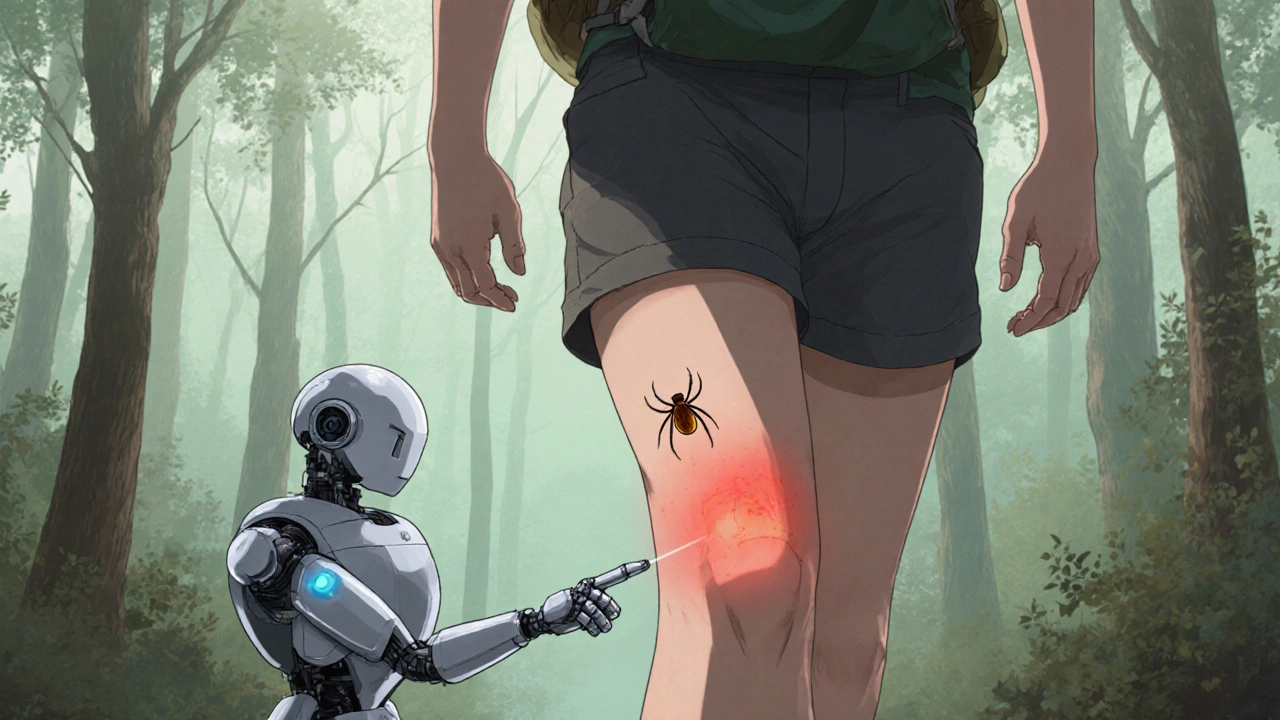Many people notice sharp or achy joint pain after a summer hike, but rarely suspect the tick‑borne culprit known as Lyme disease. Understanding how the two are linked can spare you months of confusion and unnecessary doctor visits.
Lyme disease is a bacterial infection transmitted by the bite of infected Ixodes ticks. The responsible pathogen, Borrelia burgdorferi, can invade skin, nervous system, heart, and joints.
Joint pain refers to discomfort, stiffness, or inflammation felt in any of the body's articulations. It can arise from injury, arthritis, infection, or immune reactions.
Key Takeaways
- Lyme disease often starts with a rash, then spreads to cause joint pain weeks to months later.
- Joint pain from Lyme disease typically affects large joints, especially the knees.
- Blood tests (ELISA, Western blot) combined with clinical signs are required for accurate diagnosis.
- Early antibiotic treatment clears infection and usually resolves joint symptoms.
- Persistent joint pain after treatment may need anti‑inflammatory meds or physical therapy.
How Lyme Disease Leads to Joint Pain
After a tick bite, the bacteria travel through the bloodstream and settle in tissues. In the early stage (often 3‑30 days), the classic “bullseye” rash called erythema migrans appears. If untreated, the infection can disseminate, reaching the joints. The bacteria trigger an immune response that produces inflammatory chemicals-such as cytokines and prostaglandins-that inflame the synovial lining of joints.
This inflammation is called Lyme arthritis. It usually targets the knee, but can involve elbows, wrists, ankles, or even the spine. Patients describe a deep, throbbing ache that worsens after periods of inactivity and improves with gentle movement-a pattern opposite to most mechanical injuries.
Typical Timeline of Symptoms
- Day 0‑7: Tick bite, possible flu‑like symptoms (fever, chills, headache).
- Day 3‑30: Erythema migrans appears at the bite site. Some people feel joint stiffness but it’s often mild.
- Weeks to months: Bacteria seed joints, causing swelling, warmth, and pain, most often in the knees.
- 3‑6 months: If untreated, joint swelling can become chronic, leading to limited range of motion.
Knowing this timeline helps clinicians connect early nonspecific symptoms with later joint problems, reducing misdiagnosis.

Diagnosing Lyme‑Related Joint Pain
Because joint pain is a common complaint, doctors rely on a combination of history, physical exam, and lab tests.
- Exposure history: Recent time spent in tick‑infested areas (e.g., woodlands of the UK, Northeastern US).
- Physical exam: Swollen, warm joint with limited flexion, often without severe redness.
- Serologic testing: A two‑tiered approach-first an ELISA to screen, followed by a Western blot to confirm. Positive results must be interpreted alongside clinical signs.
- Synovial fluid analysis: In doubtful cases, aspirating joint fluid can reveal white‑blood‑cell counts typical of inflammatory arthritis, and PCR may detect bacterial DNA.
False‑negative tests are possible early in infection; repeat testing after 2‑3 weeks improves accuracy.
Lyme Arthritis vs. Other Joint Disorders
| Feature | Lyme arthritis | Rheumatoid arthritis |
|---|---|---|
| Typical onset | Weeks‑months after tick bite | Gradual, often years |
| Commonly affected joints | Large joints (knees, elbows) | Small joints (hands, wrists) |
| Presence of rash | Erythema migrans in ~70% of cases | Rare |
| Serology | Positive ELISA/Western blot for Borrelia | Positive rheumatoid factor or anti‑CCP |
| Response to antibiotics | Often resolves within weeks | None; requires DMARDs |
This side‑by‑side view helps patients and clinicians spot red flags that point toward a tick‑borne cause rather than classic autoimmune arthritis.

Treatment Options for Lyme‑Related Joint Pain
The cornerstone of therapy is antibiotics. The CDC recommends a 2‑ to 4‑week course, typically doxycycline (100 mg twice daily) for adults without contraindications. Alternatives include amoxicillin or cefuroxime for pregnant women and children.
Most patients feel pain relief within a few days of starting antibiotics; full resolution of swelling usually occurs within 2-3 weeks. In rare cases where joint inflammation persists (so‑called “post‑treatment Lyme disease syndrome”), doctors may add a short course of non‑steroidal anti‑inflammatory drugs (NSAIDs) and recommend physical therapy to restore motion.
Key points for effective treatment:
- Start antibiotics early-delays reduce success rates.
- Complete the full prescribed course, even if symptoms improve.
- Monitor joint size and pain daily; report worsening swelling.
- Combine medication with gentle range‑of‑motion exercises.
- Consider referral to a rheumatologist if pain lasts beyond 3 months.
Managing Persistent Joint Discomfort
About 10-15% of patients notice lingering stiffness after the infection clears. This is usually due to residual inflammation rather than active bacteria. Strategies include:
- Low‑dose NSAIDs taken with meals to protect the stomach.
- Regular low‑impact activities-swimming, cycling, or yoga-to keep joints lubricated.
- Strengthening exercises targeting quadriceps and hamstrings, which support the knee.
- Heat packs or warm showers before stretching to reduce stiffness.
- Periodic check‑ups with blood tests for inflammatory markers (CRP, ESR) to ensure the body isn’t mounting a new autoimmune response.
If symptoms continue beyond six months, a short trial of a disease‑modifying drug may be considered, but only after infectious causes are ruled out.
When to Seek Medical Help
Joint pain alone isn’t an emergency, but certain signs demand prompt evaluation:
- Sudden swelling of a joint accompanied by fever.
- Joint pain that worsens despite rest and over‑the‑counter painkillers.
- History of a recent tick bite or outdoor exposure in endemic zones.
- Development of a rash that expands beyond the bite site.
- Neurological symptoms such as facial palsy or severe headaches together with joint discomfort.
Early professional assessment can prevent chronic arthritis and limit long‑term disability.
Can a simple knee sprain be confused with Lyme arthritis?
Yes, early Lyme arthritis can mimic a sprain because both cause swelling and pain. The key differences are a history of tick exposure, possible rash, and lack of a specific injury event. Blood tests for Borrelia help confirm the infection.
How long after a bite does joint pain usually appear?
Joint symptoms typically emerge weeks to a few months after the bite, once the bacteria have spread to the joints.
Are there any home tests for Lyme disease?
No reliable at‑home test exists. Diagnosis requires laboratory analysis (ELISA followed by Western blot) performed by a medical lab.
What antibiotics are safest for children with Lyme arthritis?
Amoxicillin is the first‑line choice for children under 8 and for pregnant women, taken for 21‑28 days.
Can Lyme disease cause permanent joint damage?
If treated promptly, permanent damage is rare. Delayed therapy may lead to chronic inflammation and arthritic changes, especially in the knee.
